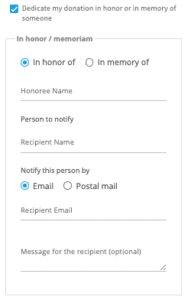This post was guest-written by our friends at Donorbox, a donation platform that can be set up quickly and easily on your website OR on a Donorbox-hosted Fundraising Page. They’ve worked with more than 35,000 organizations around the world, helping them increase their donations by providing an excellent donation experience. Best of all, there’s no setup fee, no monthly fee and no contract required to start using Donorbox, so visit www.donorbox.org to sign up today!
During the Covid pandemic, nonprofits were forced to move most of their fundraising online. An unexpected benefit of this fundraising change was an increase in online fundraising. The pandemic may have made online fundraising more necessary, but online giving has risen every year for the last decade.
This form of fundraising is not going anywhere, but how can a nonprofit make sure their online fundraising is bringing in donors, not scaring them away? With the following six additions to your online fundraising page, you can make sure donors do not leave your website without giving. Increases in online fundraising mean very little if you cannot capitalize on the trend.
Remind Donors Why They Should Give
When a donor reaches your donation page, they are already interested in giving, but that does not mean their gift is a lock. Donating is a very personal thing. A reminder of why they are giving does not take a lot of time and will increase their chances of donating. It may even convince them to give more.
There are a few easy ways to do this on your online fundraising page.
Call to Action
A call to action is exactly what it sounds like. When people visit your website, you want them to act by signing a petition, volunteering, or, better yet, donating to your cause. These statements should be scattered across your solicitation emails and social media posts to encourage donors to click on the donation link. It is best practice to place a call to action in the beginning, middle, and end of your solicitation letters.
If the first calls to action worked, the donor has clicked on the link and landed on your website. Once they have arrived, you will need a different call to action to get them to take that final step and donate. Include this call to action on your fundraising page and your donation form to give them that last little push.
Image and Success Story
On your donation page, you can also show your mission in action. A powerful image and success story on your fundraising page will tug at the heartstrings and help increase online donations. Give your donors a taste of what their gifts can do with stories and pictures of your organization’s beneficiaries.
Simplify your Donation Form
After convincing donors to give, you want to make it as easy as possible. Donors will only spend a few seconds before clicking away if the form looks too complicated or time-consuming.
It may be great for your donor database to collect as much information as possible, but your online donation form is not the place to do it. Remember, the easier it is to donate online, the more likely they will return and give again.
When creating your donation form you want to stick with three simple steps:
- Donation amount
It is best to include no more than six donation amounts. When deciding on these amounts, use the donors’ past gifts to determine where to start. If your donors regularly give $100, start with that amount and add higher donation amounts to encourage larger gifts. Always have a custom donation amount for donors to choose their own gift size.
- Donor information
Do not ask for too much donor information. Asking donors to spend too much time on your donation form may discourage them from finishing their donation. Donors give online because of the convenience. Asking donors to include an autobiography with their donation can feel excessive.
- Donate Button
You have already added your call to action statements on your fundraising page and at the top of the donation form, but including a colored button with a call to action will give donors that final push to give. Giving donors a button to push after entering their donation amount and bank information, gives them the chance to review their information and feel good about their gift.
Include Donation Tiers
One of the best ways to increase a donor’s gift is with donation tiers. These tiers give donors a few different amounts and show the impact each gift amount can make. If your nonprofit needs $100 for a year of primary school education, or $3,000 to help build a new school, let donors know. Including these descriptions increases the chance donors will give more.
Best practice says to include three to six donation amounts on your fundraising page. These amounts can range from $1 to $1 million, but the chances of increasing a donor’s gift grow if these amounts are closer to the donor’s ability to give. A donor able to give $50 will not increase their gift to $1,000, but they may double or even triple that amount with enough convincing.
The best way to decide on which amounts to include in your tiers is by donor or campaign. If you are collecting donations from a wide range of individuals, you may want to create a separate donation page for each demographic. A doctor with her own practice can likely give more than a student, so when sending out solicitation emails, make sure you include a donation link to the right donation page.
Make Monthly Giving Easy
Smaller donors are often ignored because their donation amounts do not seem to make a big difference to a nonprofit’s budget. If you add up one of your smaller donor’s donation history and compare it to a larger donor, there may not be much of a difference. Convincing these individuals to give regularly is how you can keep these donors around.
Finding new donors is challenging. Convincing your current donors to give more may be easier than you think. Adding a recurring donation option to your donation form is one of the easiest ways to increase your organization’s revenue without spending any funds or too much extra time. Just include a button on your donation form and ask donors to give weekly, monthly, quarterly, or annually to your nonprofit.
By letting donors manage their recurring amounts, they feel like they are in charge and will show their appreciation with their continued gifts.
Let Donors Give Someone’s Honor or Memory
Gifts made in someone’s memory or honor can be one of the most personal ways a donor can give. In the case of a memorial, the individual is gone, and this donation is a way to remember the difference they have made on the donor and the world.
A donation in someone’s honor may be from a birthday or anniversary request the donor made to their family and friends. These donations are a chance for your organization to make an excellent first impression on a potential supporter. By making it easy for people to donate in someone’s name, your organization connects with new people and lets donors know you care about them.
In addition to adding an easy way to donate in someone’s name, you can also create a donor wall for these donations and show the total amount given in their honor. Donor recognition is vital for nonprofits, and a donor wall is one of the easiest ways to let them know they are needed and appreciated. Donor walls can be physical walls displayed at a nonprofit’s location or an addition to your online fundraising page.
Make Sharing Easy
Social media has forever changed the way people donate. Applications like Facebook, Instagram, and Twitter have included methods for nonprofits to promote their organizations and ask for and collect donations.
Peer-to-peer and crowdfunding campaigns are ways people can spread the word about nonprofits they support. Birthday or anniversary fundraisers are a common sight on social media. The old ideas of not asking your friends to give money or sharing that you gave to a nonprofit are a thing of the past.
People love to feel like they are making a real difference. By sharing their donations with those they love, donors can let them know what they care about and that they are doing something about it. Nonprofits that offer the chance to share their donations on social media are capitalizing on this trend and will likely see the benefit right away.
Supporters with their own crowdfunding page should regularly add information to encourage more donations. Sending these supporters pictures and success stories to share and a thank you message to give their donors one they give will help make their fundraising efforts successful.
Younger donors are more comfortable sharing everything online. These donors want to make a difference in your cause and love to get their friends and family involved. Adding a button to your online fundraising form to share their donation online is an easy first step. Gain these donors’ advocacy and reach an entirely new donor base.
Final Thoughts
Donating online has already become the norm. As more donors grow up with the internet and social media, their interest in donating online expands. As technology advances, these online donors will find new ways to give online.
Almost 30 percent of all online giving was done on mobile phones. Mobile giving is increasing too, so an online fundraising page that displays well on the phone is essential. Other forms of mobile giving, like text giving, are also growing and increasing the revenue of smaller nonprofits and churches because of its ease of use.
The online giving trend is not going anywhere, and those nonprofits that do not have online donation forms are missing out on thousands of donors and their gifts.
Online donors are more informed and are looking for easy ways to give with the most impact. You will want to make sure your donation page is prepared. With the six suggestions we made in this article, your nonprofit can make a good impression on online donors and increase their gift amounts.
Donorbox has many features to help you create a convenient and customizable donation form on your website. Our blog includes marketing and management tips and information to help you with your next online fundraising campaign.







